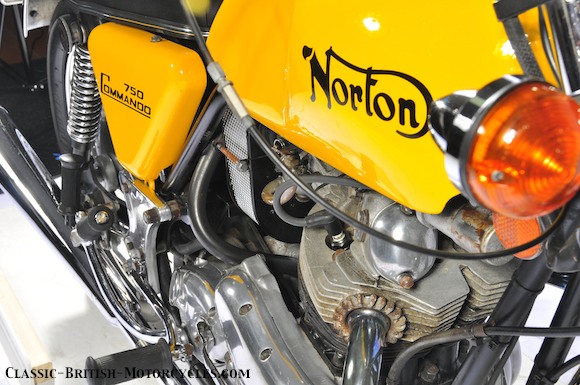1972 Norton Commando
1972 NORTON COMMANDO MODEL DESIGNATIONS
All four road models became MkIVs & one completely new model was added, the Commando Interstate, meant to be a long-distance touring bike, with a 5-gallon fuel tank.
ENGINE CHANGES FOR ALL MODELS
All models got reinforced crankcase castings with more internal webbing around the main bearings, & a roller race on the timing side to match the drive side main bearing. This meant that crankshaft location was lost & the crank could float back & forth, so shims were needed to control the end play, not a good arrangement. The sump filter was also removed, meaning the scavenge pump was unprotected from debris. They added an inline oil filter on the return line between the engine & gearbox. The timed breather on the end of the cam was eliminated & a breather with separator was installed on the lower back of the crankcase, running to the oil tank.
1972 Norton Commando
PRODUCTION RACER
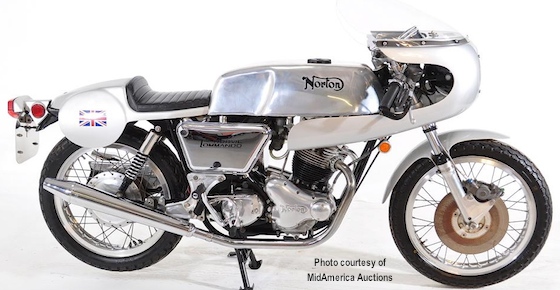
PRODUCTION RACER ROCKS
While there were actually no mechanical differences between the Production Racer and other versions of the Commando, they had the look and stance of a lean, mean road racer. It was an appearance package, really, as were all the Commando models. In this case, the Proddy got a large alloy gas tank, oil tank, bum-stop seat with built-in number plates, racy front fender, and one of the coolest half-fairings every made. Many normal Commandos have been converted to this look, and are referred to as Production Racer Replicas.
1972 Norton Commando COMBAT

COMBAT ENGINE
The big news for the 1972 Norton Commando line was the addition of a new, highly-tuned version of the 750 twin, called the Combat engine. Little did anyone know at the time just how bad this engine was or just how much trouble it would cause Norton.
COMBAT SPELLS TROUBLE
The 1972 Norton Commando came with an option on the Commando Roadsters & the new Commando Interstate for a ‘hotter’ engine, called the Combat. All Combat engines came with their cases painted black. The advertised extra 5hp came from a bump in compression ratio to 10.0:1 (by shaving the head surface), larger 32mm Amal 932 Concentric carburetors, larger intake tracts to match & a wild high-lift, long-duration cam. The engine proved to be “peaky”, with good power in the upper rpm-range, but not so good in the low- & mid-range. So, they geared it down with a smaller front sprocket to help acceleration. This meant it would top out at 108mph at 7,000 rpm, not exactly what you’d expect from a racing engine. This low gearing made it all to possible to over-rev the engine, even in top gear. The pistons, the same slotted versions used since the Norton Atlas, worked fine at 5,000rpm, but at 7,000 under extreme loads, then tended to pull the crowns loose from their skirts.
MORE COMBAT WOES
In addition to everything else, the cam chains were so awkward to adjust that they rarely were. Since the points were attached to the timing side of the cam, not only would cam timing vary, but so did ignition timing. Add to that a lousy auto-advance mechanism that fluctuated or even jammed. Everything combined conspired to drastically reduce main bearing life to as low as just 4,000 miles, if the rest of the engine lasted that long, that is.
COMBAT MARCHES ON
The Combat engine was coupled with a front disk brake on the Norton options list. Despite all the problems, the Combat engine & disk brake were such a popular item that by mid-year, they were included on every 1972 Norton Commando of every type. Problems & warranty claims went through the roof, badly tarnishing Norton’s good name in the eyes of the public. The venerable old front drum brake was dropped from the catalog & only Norton Commando Hi-Riders would have one by 1973. All others had front disk brakes from them on.
THE HEART OF THE PROBLEM
The problem, as it turned out, was partly due to the conflict created between the old, flexible crankshaft & the new, more-rigid crankcase. And they took it out on the main bearings, which was exacerbated by the change of the timing side main bearing to a caged roller. As the crank flexed under heavy loads at high rpms, the corners or edges of the rollers were digging into their races.
A SOLUTION
The answer was a self-aligning spherical roller bearing called a Superblend. These had rollers that were slightly barrel-shaped, having softer rounded corners that allowed some flex & didn’t dig into the races. New, unslotted pistons were fitted & the auto-advance mechanism was improved. And a larger front sprocket was fitted, raising the gearing such that owners couldn’t over-rev their bikes in top gear anymore. But the ultimate solution to the Combat Engine Fiasco was to eliminate the Combat engine. Norton Motorcycles decided that it was more important to focus their resources on their mainstream engines instead, applying what the improvements intended for the Combat to the entire engine line.
1972 Norton Commando INTERSTATE
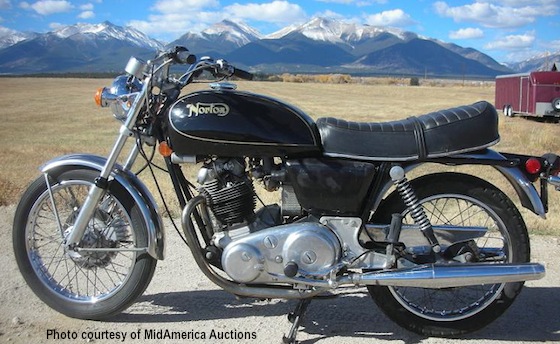
NORTON COMMANDO INTERSTATE
A long-range touring bike was added to the Commando lineup. It was known as a Commando LR (for Long-Range) or a Commando Interstate this first year, depending on who you talked to. From ’73 on, it was known only at the Commando Interstate. Note the larger gas tank.
1972 Norton Commando FASTBACK
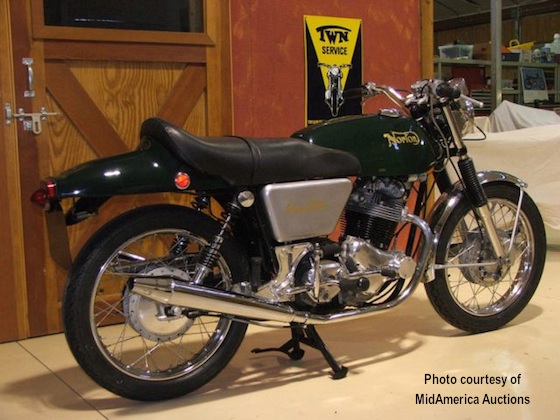
COMMANDO FASTBACK
The Fastback was the first Norton Commando model, back in 1969. Basically the same as every other Commando, the Fastback had a special seat and fiberglass back fender extension.
1972 A BAD YEAR
Busy doing all that frantic development work & a steady stream of warranty work, very few Norton Commandos were actually available to sell in late 1972. It would not be until 1973 that Norton Commando full-scale production got underway again.
THE JOHN PLAYER CONNECTION
Norton Motorcycles got a nice boost in the form of sponsorship of their racing team by John Player Cigarettes. This had little effect on the problems in the factory at that time, but went a long way toward establishing Norton’s prestige even outside the motorcycle industry.
1972 Norton Commando ROADSTER
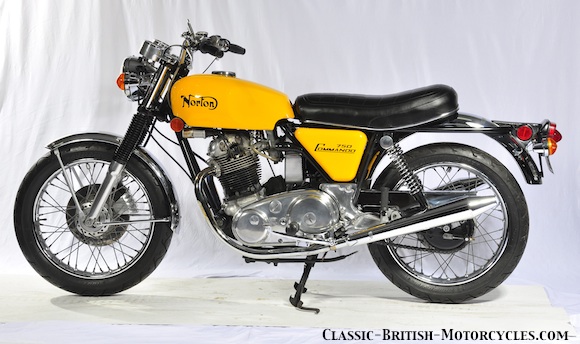
1972 NORTON COMMANDO ROADSTER
While the Fastback was the first Commando model introduced in 1968, the Roadster soon became the standard model. It’s the one most people think of when they hear “Norton Commando”.
1972 Norton Commando HI-RIDER

HI-RIDER APES THE CHOPPER CRAZE
The movie “Easy Rider” kicked off the chopper craze of the late-60s and early-70s. Harley had the Super Glide, Triumph has the X-75 Hurricane, so Norton felt it had to follow suit. Unfortunately, their ill-conceived and poorly-executed result was the hideous and totally impractical Commando Hi-Rider. Ridiculous “ape-hanger” handlebars, and that absurd “banana seat” with sissy bar were summarily hung onto stock Commando Roadsters in an attempt to cash in on the chopper craze. Few were sold, and many were converted by dealers back to normal Roadsters before they could find buyers. Many more were converted back to standard bodywork by the owners after the sale. So ironically, today, unmolested bikes are rare and somewhat sought-after by collectors.
1972 Norton Commando SPECIFICATIONS
|
Model designations:
Engine type Displacement Bore & Stroke Compression Carburetors Ignition Engine output Oil system Oil capacity Primary drive Clutch Gearbox Ratios, overall: 1st, bottom 2nd 3rd 4th, top Final drive Frame type Suspension, front Suspension, rear Brake, front Brake, rear Wheelbase Seat height Weight |
Fastback MkIV Interstate Roadster MkIV Street Scrambler Production Racer Hi-Rider Air-cooled OHV parallel twin 746cc / 45 ci 73mm X 89mm / 2.875″ X 3.503″ 9.0:1 2- Amal Concentric, 30mm Battery & coil, Lucas 58 bhp @ 6500 rpm Dry sump 6 pts Triplex chain Multi-plate diaphragm, wet 4-speed constant-mesh, right-foot shift 12.40:1 8.25:1 5.90:1 4.84:1 Chain Welded double cradle, Isolastic Suspension Telescopic fork, hydraulic damping Swing Arm, 2 dampers, Isolastic mounts 8″ TLS drum, full width 7″ SLS drum, full width 57.1″ 31.3″ 431 lbs |


